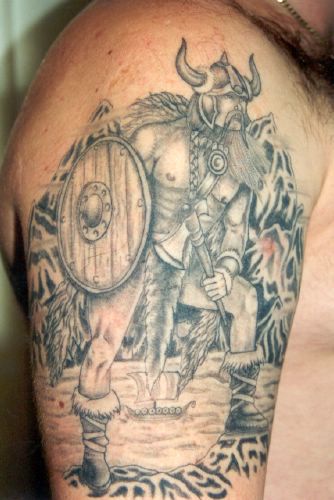 One of the most popular Viking tattoo designs is meant to represent an actual Viking warrior. If you are to get a Norse tattoo, you would probably want to have an image of something real, historically accurate. Then reject all the designs that represent Norsemen wearing helmets with horns. Such a presentation of a Scandinavian helm grew popular as late as in the 19th century. The only extant authentic helmet that dates back to the Viking Age was found in Gjermundby, Norway, and it has no horns. Norse warriors were very practical people and their weapons' designs were usually rather simple. They valued usability, not spectacular effects. It is true that there are a few Viking Age images representing ceremonial helmets with two protrusions ending with birds' or snakes' heads, but they look altogether different and were not used in battles.
One of the most popular Viking tattoo designs is meant to represent an actual Viking warrior. If you are to get a Norse tattoo, you would probably want to have an image of something real, historically accurate. Then reject all the designs that represent Norsemen wearing helmets with horns. Such a presentation of a Scandinavian helm grew popular as late as in the 19th century. The only extant authentic helmet that dates back to the Viking Age was found in Gjermundby, Norway, and it has no horns. Norse warriors were very practical people and their weapons' designs were usually rather simple. They valued usability, not spectacular effects. It is true that there are a few Viking Age images representing ceremonial helmets with two protrusions ending with birds' or snakes' heads, but they look altogether different and were not used in battles.The same applies to wings. Helmets with wings are not historic. Vikings did not use them. A rather popular tattoo design is valkyrie wings based on the Max Payne movie. In that movie people see valkyries as male demonic creatures with wings. The fact is that in Norse mythology valkyries are female deities with no wings. They were pictured as serving drinking horns to warriors coming to Valhalla, a place where brave people came after their death.
The other thing to avoid in authentic Viking tattoo designs is the massive double axe. The axes used by Norsemen were rather light and used single-handed. In the period of transition from the Viking Age to Middle Ages, Scandinavians also used the so-called Dane axe, which was indeed large, but it was not double. No double-headed axe has been found from early medieval Europe.
 A Norse inscription is perhaps the best way to make your Viking tattoo design truly unique. However, getting a correct inscription is a real challenge. I would advise to proceed as follows:
A Norse inscription is perhaps the best way to make your Viking tattoo design truly unique. However, getting a correct inscription is a real challenge. I would advise to proceed as follows:
- Decide whether you'd like to have an inscription in runes or letters
- If you want it in runes, decide which runic system to use (there are several different runic alphabets)
- If you still want it in runes, decide if it will be in Old Norse or just English words in runes
 If you want the inscription in runes and you've got the exact idea of what the inscription will be (you have the text in English or in Old Norse), then the next step is to decide which runes to use. The Elder Futhark was used by all Germanic tribes from the 2nd through the 8th centuries. The Younger Futhark started to develop at the end of the 8th century and was accepted in the whole of Scandinavia by the 10th century. It existed in two versions: Long Branch and Short Twig Younger Futhark. You may also want to use Anglo-Saxon runes. There existed even a secret variant of runes called staveless runes.
If you want the inscription in runes and you've got the exact idea of what the inscription will be (you have the text in English or in Old Norse), then the next step is to decide which runes to use. The Elder Futhark was used by all Germanic tribes from the 2nd through the 8th centuries. The Younger Futhark started to develop at the end of the 8th century and was accepted in the whole of Scandinavia by the 10th century. It existed in two versions: Long Branch and Short Twig Younger Futhark. You may also want to use Anglo-Saxon runes. There existed even a secret variant of runes called staveless runes.



















